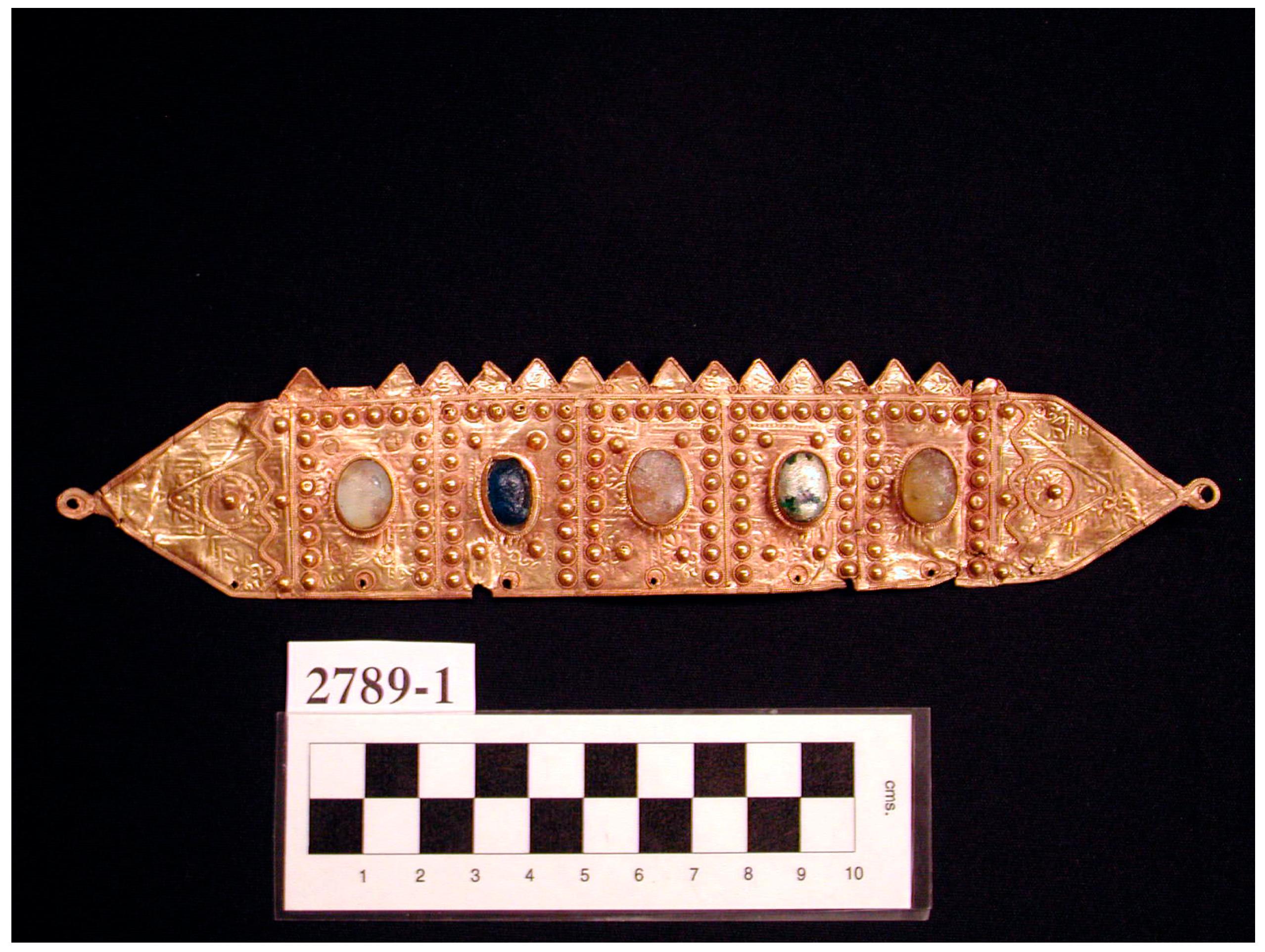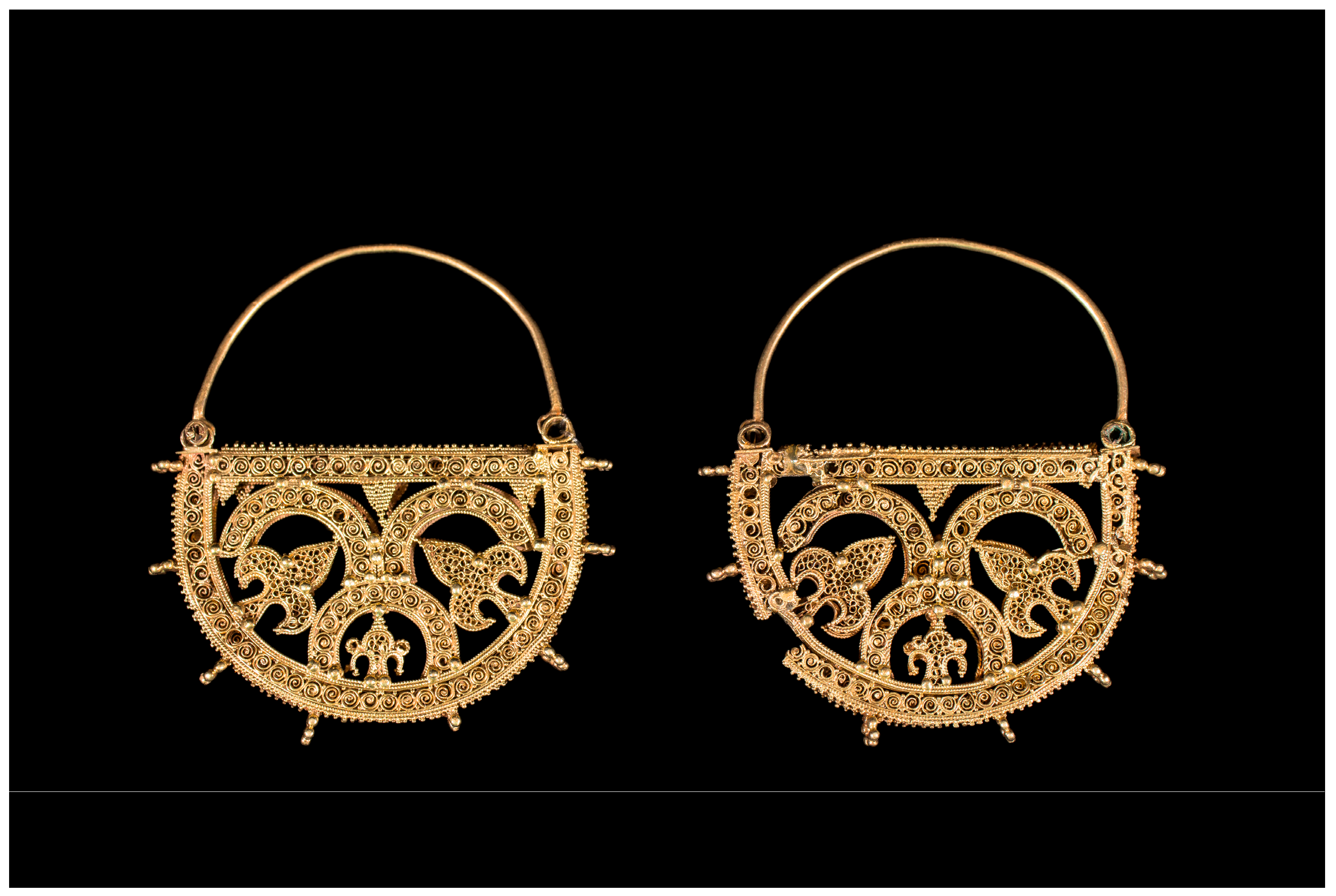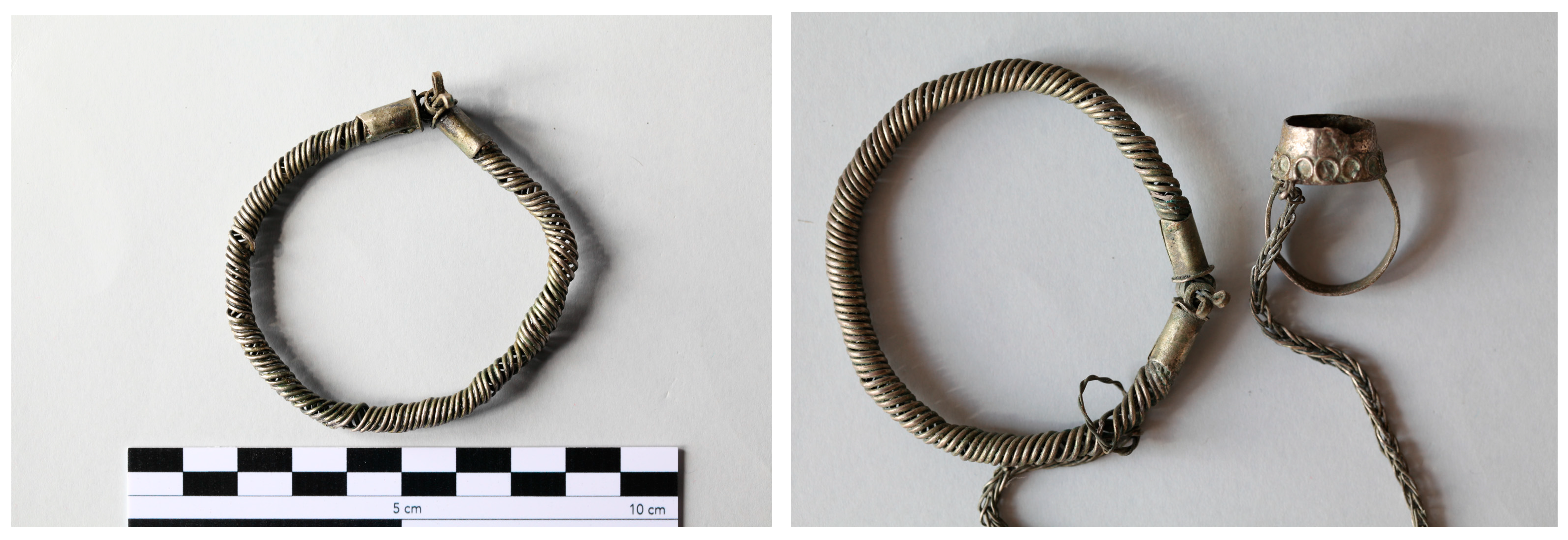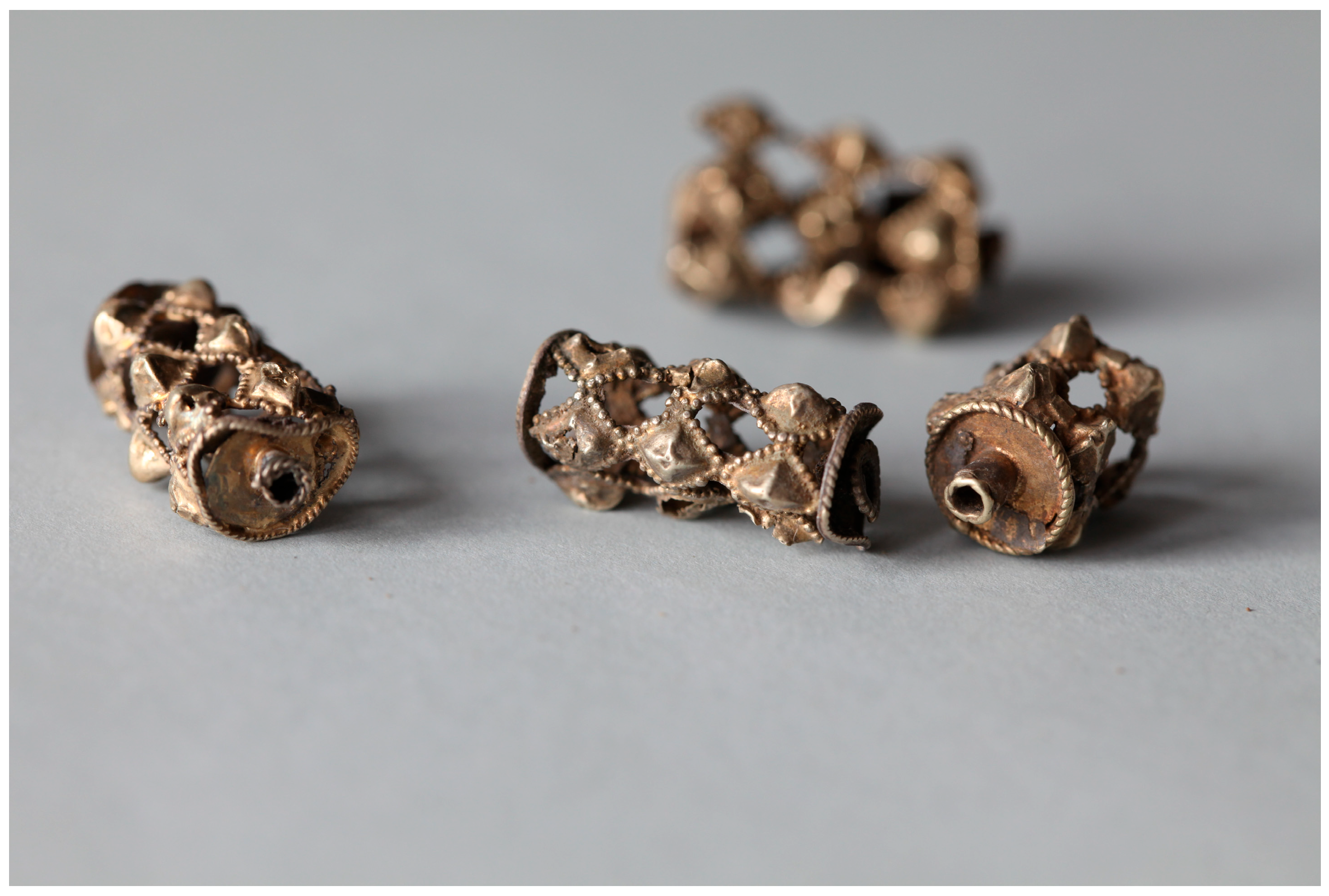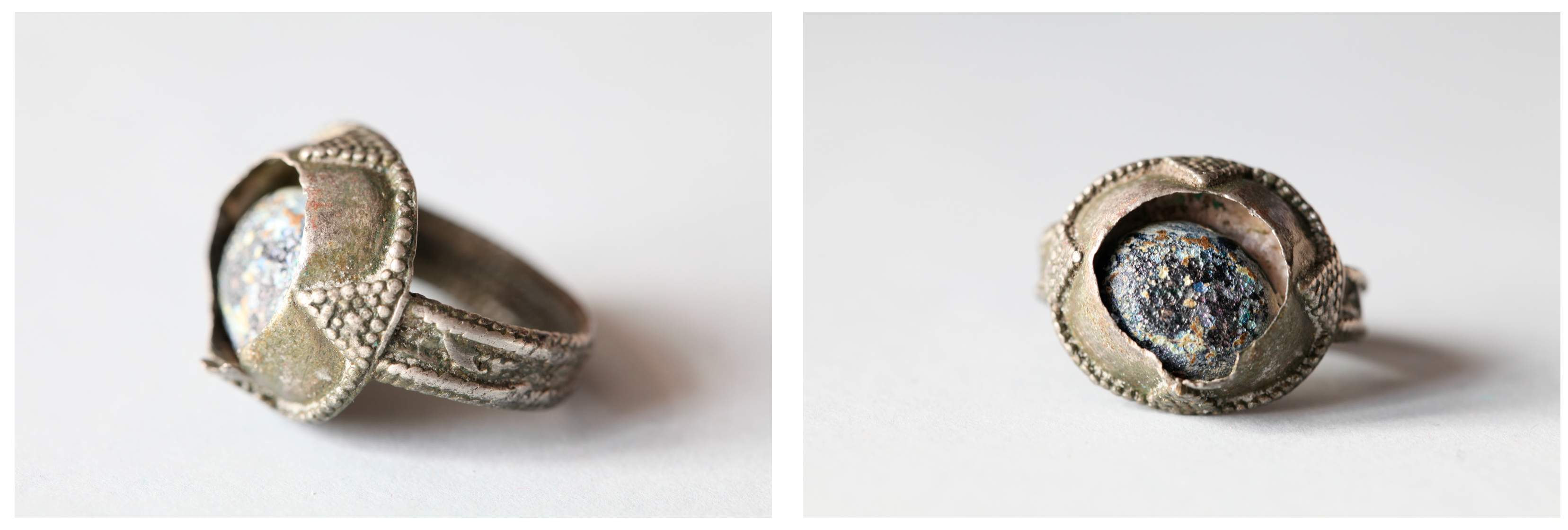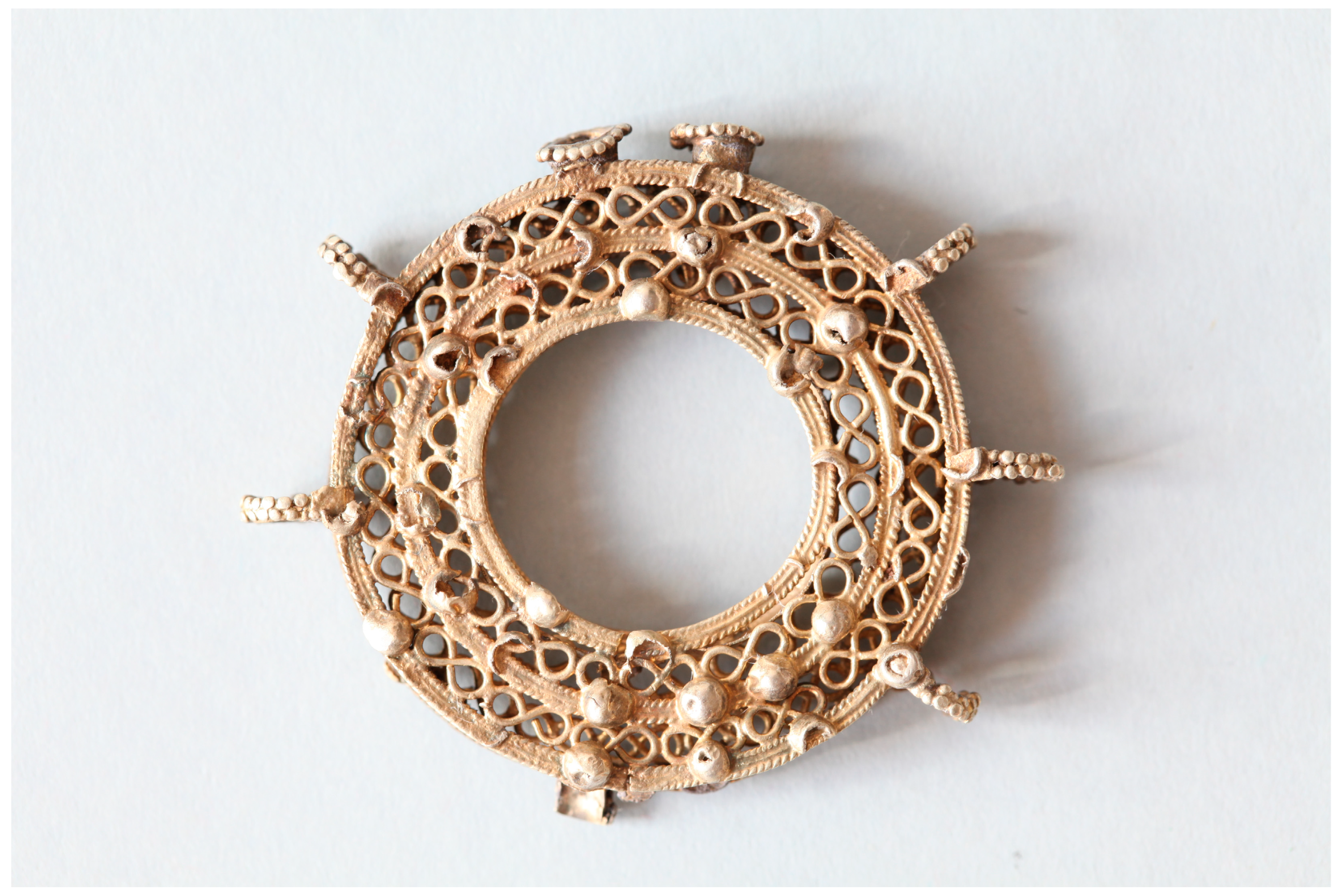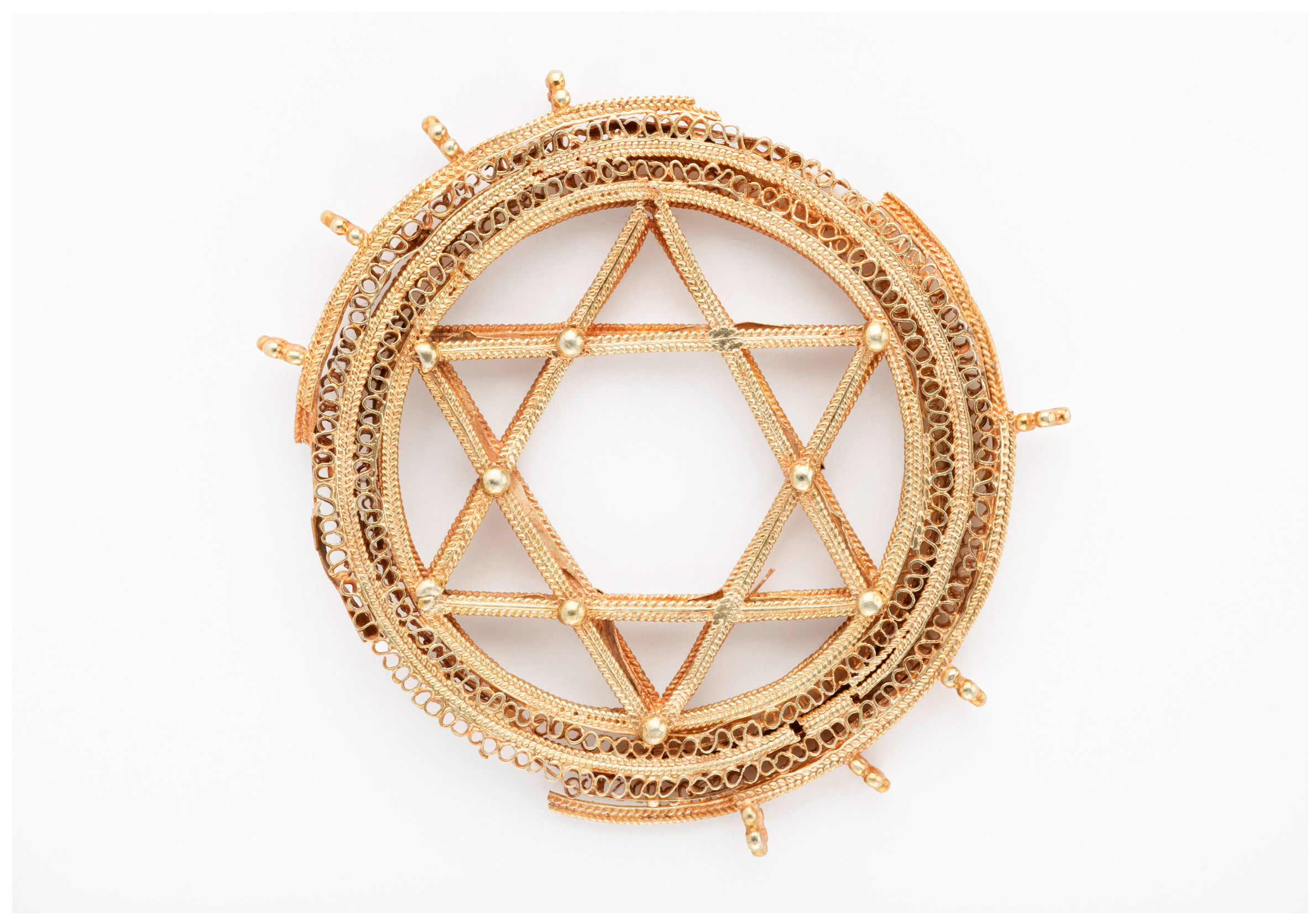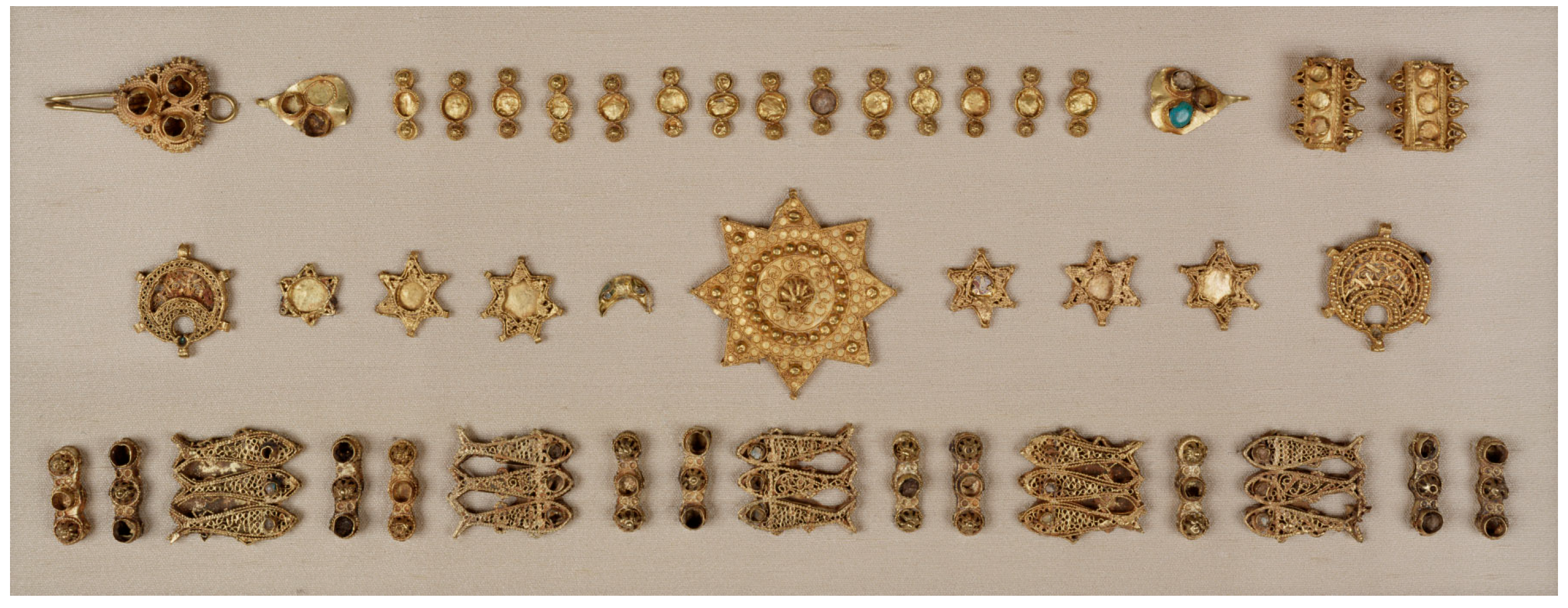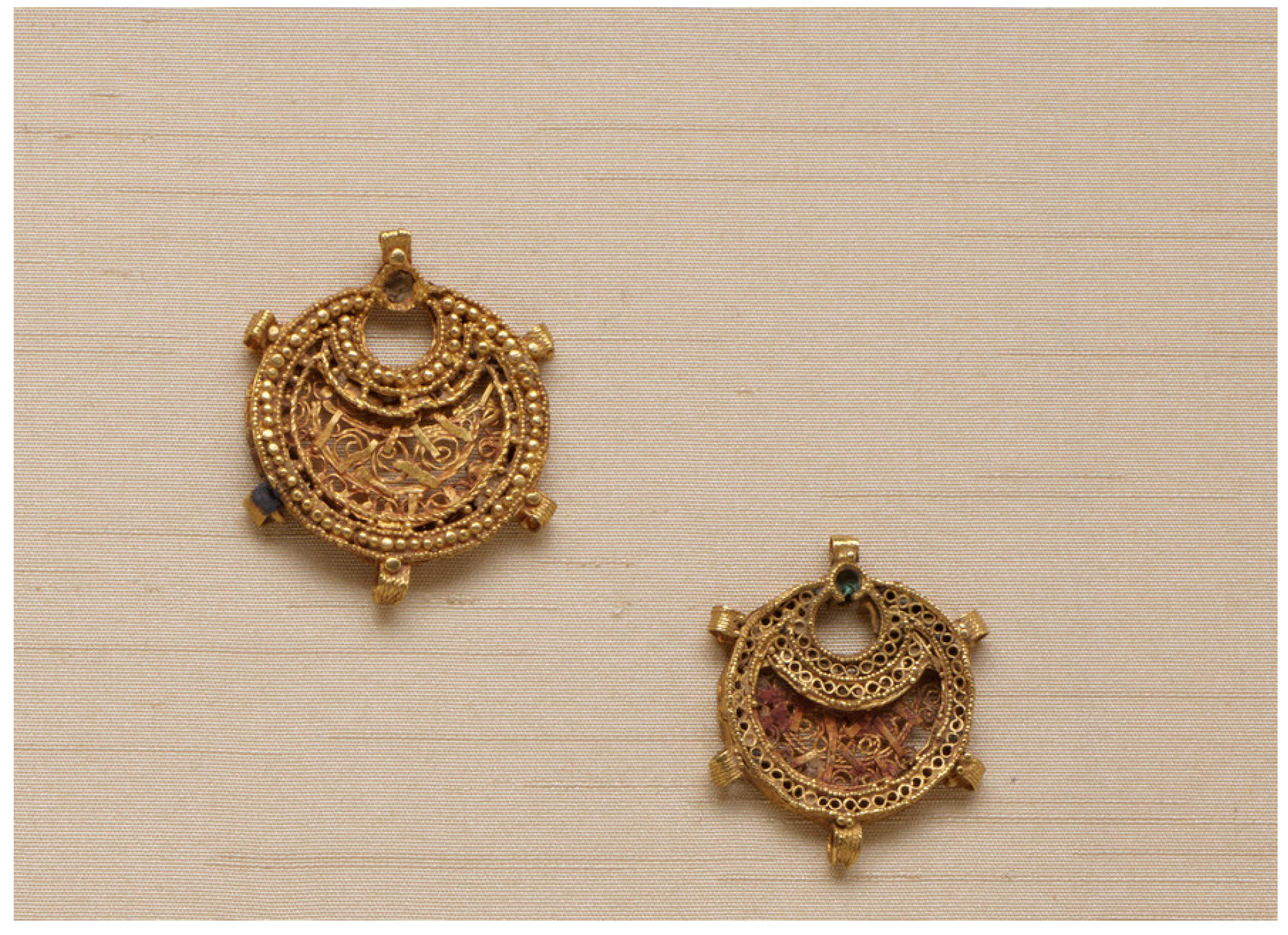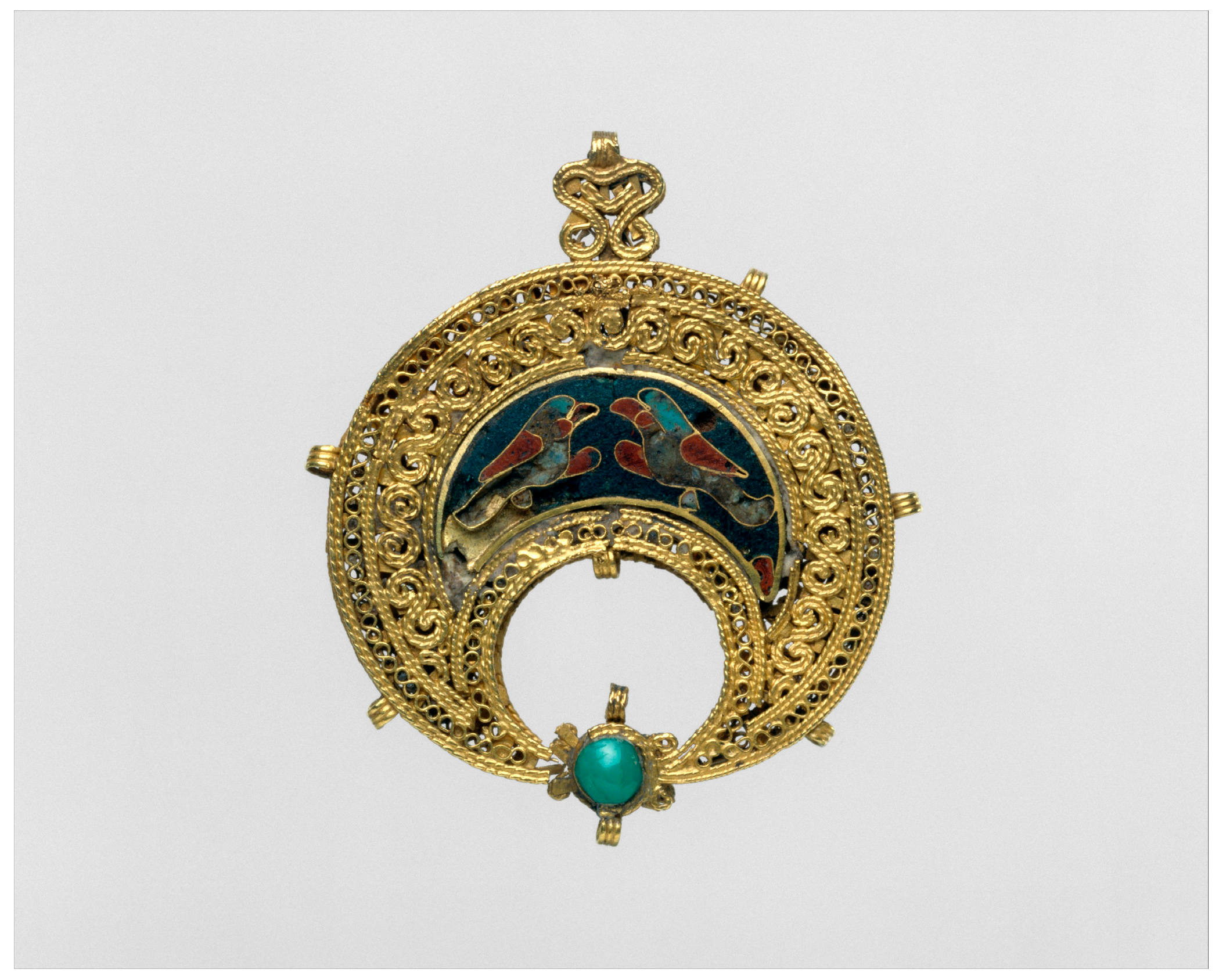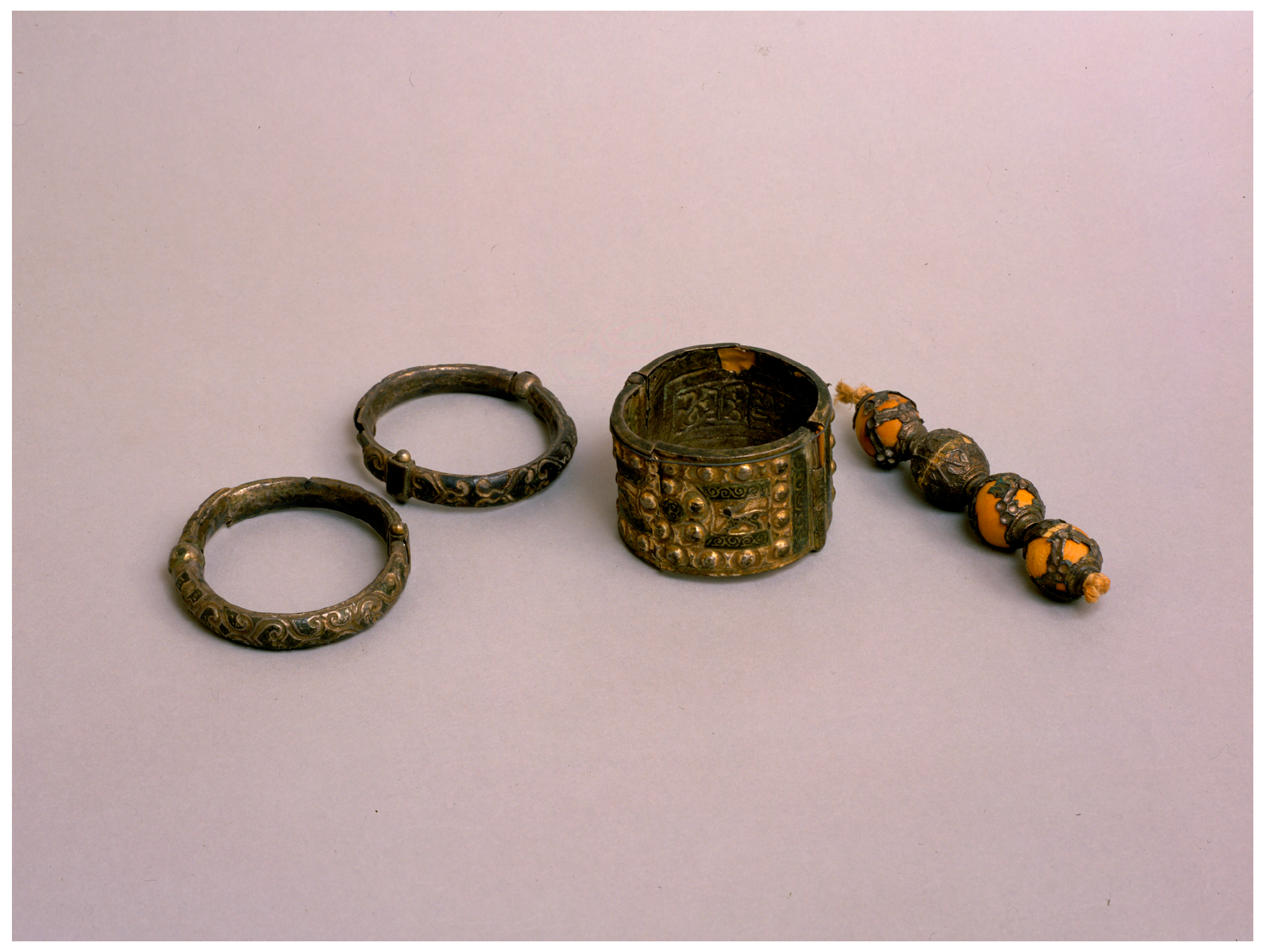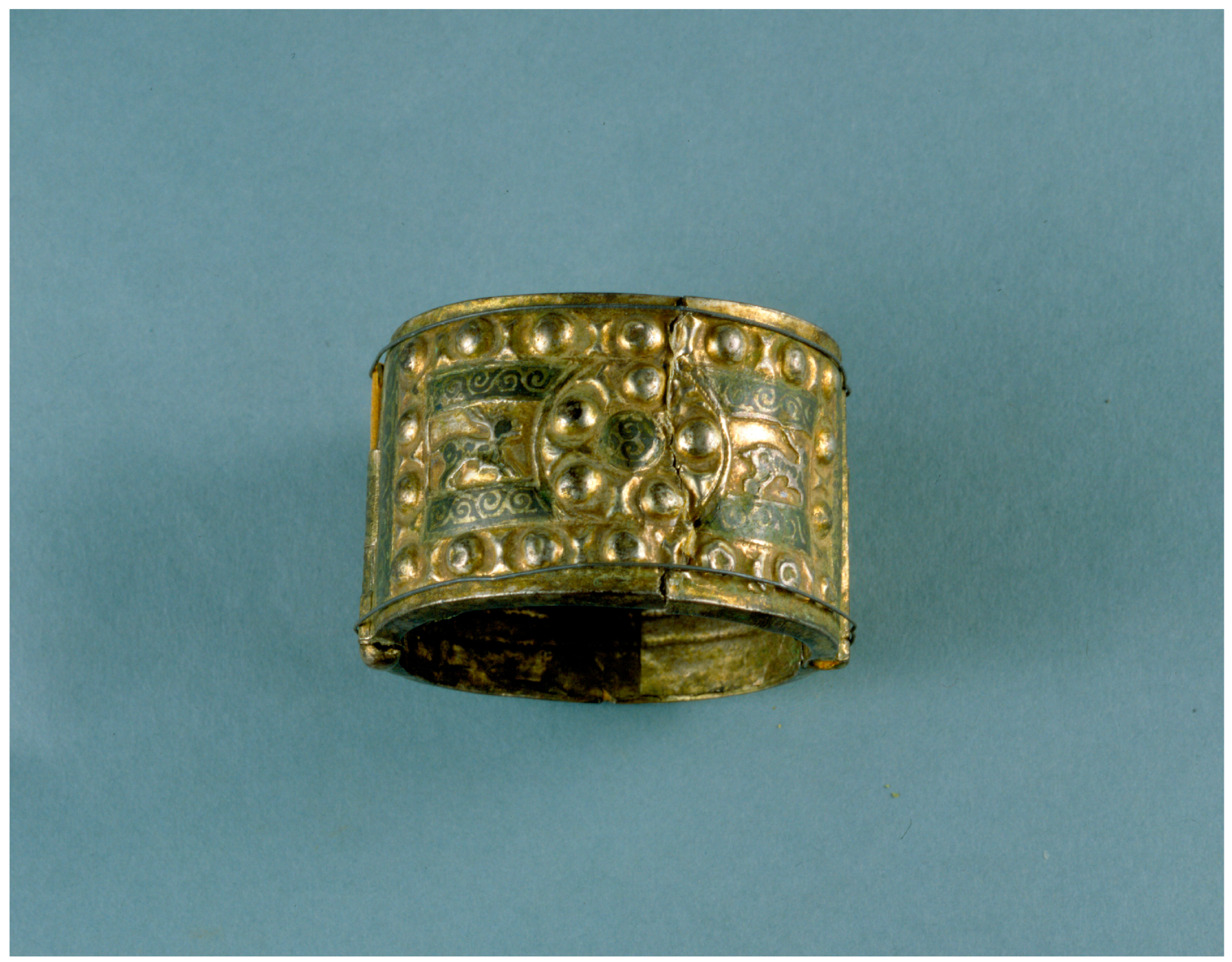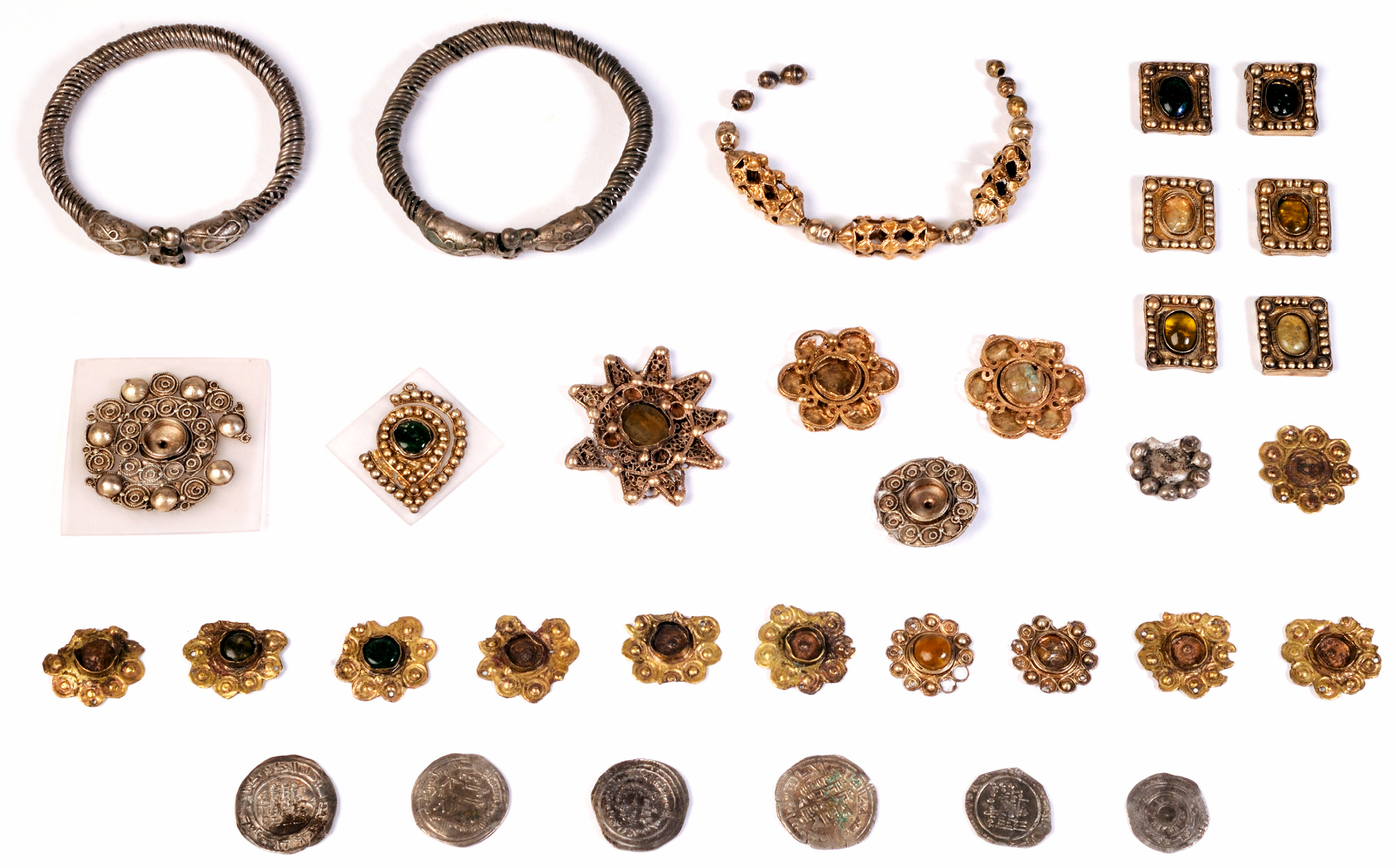2.1. Jewelry as an Image of Power
In the texts, the term Dār al-Ṣinā ͑a appears, which designates the arsenal or “House of trades” (other workshops). In addition, the sources mention metalsmithing and weaving workshops staffed by the sovereign’s slaves, the fityān, who were people of his utmost confidence. As of the proclamation of the Caliphate of Córdoba in 316H./929 by ‘Abd al-Raḥmān III an-Nāṣir (300H./912-350H./961) and the foundation and construction of the Madīnat al-Zahrā’, circa 323H./936, the Dār al-Sikka, or Mint, was moved to the new city, and it is known that as of the year 334H./946, it was already functioning, and that, in the same way, new official workshops were created there for the production of luxury manufactures, such as textiles, ceramics, works of ivory, and metalwork, among others. However, it is evident that in Córdoba, the existing workshops dedicated to the production of these objects continued to operate, and new ones were probably created, as in other cities of al-Andalus.
Based on the study of the pieces of jewelry featured in this article, or sets of them, similar, almost identical features may be observed in pieces of varying origins, but from the same period, which suggests the existence of a common workshop or a crew of artisans, possibly itinerant. In any case, the influence of Eastern models, especially in earrings and pendants, evidences ideas found in Eastern pieces present in al-Andalus, or even the existence of some master hailing from Fatimid Egypt or another point in the Islamic East. The model had to be transferred to the mold for the casting of the piece, which was repeated and extended to various points across al-Andalus, as if it were a pattern or stamp. In fact, it is known that for the crafting of these pieces of jewelry, foundry molds made of stone were used, as evidenced by the five slate plates housed at the National Archaeological Museum of Madrid (NAM), as well as other examples found across Spain (
García Carretero and Martínez Enamorado 2024;
Barceló 2023). In these casts at the NAM, dated to Umayyad times, it is possible to observe a great variety of designs, with them being used to produce simple coins bearing inscriptions praising God, pendants of various shapes, a ring, and what looks like a handle (
Álvarez 1997, pp. 1–8).
The goldwork and silverwork in the Islamic jewelry of al-Andalus (
Vallvé Bermejo 1980)
4 involved very simple techniques inherited from the Visigoths. In fact, examining the jewelry prior to the Islamic conquest of the Iberian Peninsula, it is possible to distinguish in pieces from the Caliphate and early eleventh century, which will be discussed below, a continuity in terms of the techniques employed and even their formal motifs, with elements from the East being incorporated. The most commonly used techniques consisted of embossing (repoussé), beaten gold leaf, filigree, cabochons, soldering, and glass paste. To produce gold sheets, the procedure involved hammering and reheating. Different types of decorations were applied to these sheets, such as embossing, which involves striking the sheet with a punch, on the front or on the back, on top of a surface of a certain plasticity. Another type of decoration on these sheets was achieved by chiseling or engraving, making incisions on the surface of the cold metal, using chisels and burins. Openwork and cut-out designs were also common with these sheets of metal and, of course, the soldering of gold thread onto them, generally twisted to form different silhouettes, using the filigree technique, which was developed to a high degree of perfection. The presence of soldered buttons is another common feature, whether plain, fluted, or openwork, like little domes. In the centers of the sheets, regardless of whether they were pieces for headbands or diadems, bracteates, or necklace pendants, settings were placed for stones or colored glass.
With regard to the different types of pieces that stand out within the jewelry of al-Andalus, in general, it is first worth mentioning the necklaces (ʻiqd), worn exclusively by women. These are very interesting pieces featuring tubular or spherical elements, called tutes, beads, and with glass or gold extensions, smooth or with filigree work. Colored stones were also used, as can be seen, for example, in the Treasure of Palma de Mallorca necklace, dated to the Almohad period, between the 12th and 13th centuries. The other pieces that form part of the necklaces are pendants of various shapes, referred to in Spanish with the Castillianized terms alcorcíes and candiles (
Gómez-Moreno 1951, p. 341). They could be circular, star-shaped, or lotus-shaped, probably due to Eastern influence, and also coins that were reused thanks to the soldering of a small rings and pearls or aljófares (dewdrop pearls). Ajorcas were bangles (from the Arabic jalājil, sing. jalal), including armlets, bracelets, and anklets for the wrists and ankles, usually used in pairs (
de Eguílaz 1886, p. 106). During the period studied here, they are characterized, above all, by a structure of twisted threads or wires leading to zoomorphic heads or smooth plates. Sometimes, they are circular pieces with embossed decorations, with stone settings and plant, geometric, and epigraphic motifs, crafted with incisions, often set off against the background by means of the niello technique, as in the Garrucha Treasure, which will be studied later.
The earrings (qurt) or arracadas (pendant earrings) usually feature a basket shape decorated with pairs of birds facing a depiction of the tree of life, or simply geometric bands. Bracteates, or small-format pieces, round out the types of works comprising the jewelry of al-Andalus. These are flat elements that were sewn onto clothing, as can be perceived from the holes of different shapes remaining on the surface, although the most common are floral, with different petals or lobes, or star-shaped. In the center, they contain stone or enamel settings, which would surely make for a remarkable enrichment of the attire in question, whether donned by men or women.
Finally, worthy of note are the hilts and scabbards of weapons, crafted with metalsmithing techniques, undoubtedly forming part of male ornamentation at certain parades, for their great artistic value, or as gifts for other rulers. The pieces preserved, however, correspond only to the Nasrid period, when prominent workshops specialized in the crafting of these pieces to decorate swords, and, specifically, the espada jineta granadina, a type of sword typical of the Nasrid Dynasty,
5 so they are not included in this work.
2.2. The Eastern Model in Jewelry from the Caliphate Period
There is no doubt that during the Caliphate (316H./929-422H./1031), the city of Córdoba and, possibly, Madīnat al-Zahrā’, featured workshops specialized in metalsmithing. However, of the pieces preserved, only two chests have been identified as Cordovan (
Merino Castejón 1930),
6 since, as far as the pieces of jewelry themselves are concerned, there is no documentation demonstrating that they were produced at local workshops. As for the pieces preserved from and dated to the 10th century, there are chests, scent phials, and pieces of jewelry that formed part of the “treasures”, as they are sets that were found fortuitously, accompanied by coins that have made it possible to date them. It is obvious that these are pieces that did not belong to sovereigns of al-Andalus, as they were reused at the end of their reigns by other sovereigns or stolen and sold at some point. The discovery of these treasures in lands far from power centers, buried and amassed in ceramic vessels or receptacles, suggests that they belonged to families of a certain economic and social prestige, and that they were part of these families’ assets. We should not find it surprising that families of a certain economic level accumulated pieces of jewelry, which they gave to their daughters as dowries, forming part of the šuwār (ornaments) given to them when they married. Husbands also gave their wives such pieces as gifts. Daughters were obliged to wear these jewels for certain periods, because they constituted loans, not only during the marriage ceremony, but at other family ceremonies and celebrations as well, as stated by Zomeño in her publications related to marriage from a legal point of view (
Zomeño 1996, pp. 79–96).
These treasures and pieces preserved are outstanding examples in terms of their characteristics and their crafting, but they belonged to domestic areas of lower social rank than the sets that must have belonged to al-Andalus’s sovereigns. Even though these are not pieces crafted and used at court by the caliphs of al-Andalus, their study is very worthwhile because it allows us to better understand the artistic context surrounding this type of production. Based on their formal and technical characteristics, they allow us to reconstruct and imagine what the jewels owned by al-Andalus’s high-ranking dignitaries must have been like, without a doubt featuring a level of artistic quality greater than what we see in what has been preserved. The fact that these treasures were buried and hidden is an indication that their owners wanted to protect these pieces, due to their great economic value, together with coins from the time, during a situation of conflict such as the beginning of the fitna, or civil war (between the years 399H./ and 422H./1031), which marked the end of the Caliphate. The presence of coins in most of these sets allows them to be dated. For the most part, they correspond to the second half of the 10th century and the beginning of the 11th; that is, coinciding with the crisis in the Caliphate after the death of Caliph Al-Ḥakam II (350H./961-365H./976) and the succession of his 7-year-old son, Hishām II (365H./976-403H./1013), which meant that his power-hungry hājib, Āmir al-Manṣūr (365/976-392/1002), better known as Almanzor, actually seized power. It was, precisely, after Almanzor’s death that the fitna of Córdoba broke out, leading to the end of the Caliphate and the dawn of a new stage in the history of al-Andalus: the era of the Taifas (Ṭawā’if).
Among the pieces dated to this period, the Treasure of Charrilla stands out, found in the village of Charrilla, in Alcalá la Real (Jaén/Spain), in 1977. This set was dated thanks to the coins discovered next to the pieces of jewelry, and the chronology of these four coins (dirhams) corresponds to the Caliphate of ‘Abd al-Raḥmān III an-Nāṣir (317H./929-350H./961), including one of the coins indicating the date 337 H./948, minted in Madīnat al-Zahrā’. Among all the pieces, of special note is what looks like a diadem or a kind of headband made of gold and formed by five rectangular plates (
Figure 1), their edges decorated with small, welded buttons. In the center, they feature a cabochon filled with glass paste in different colors. At the ends of the piece, there are two triangular plates decorated with embossed plant motifs, with a circular clasp on which to place a thread or ribbon securing the ornament. The five rectangular plates are framed on one side by border trim containing small triangles, with an interior decoration of embossed lotus flowers (
Zozaya 1992, p. 220;
Chicharro Chamorro 2001, p. 221;
Haro Gutiérrez 2004).
The other most significant pieces that make up the set are what may have been a belt made up of six rectangular plates, also framed by welded buttons and with glass paste cabochons in the center. There is an interesting crescent-shaped pendant, with its tips facing down, and decorations made using the embossing technique, as well as spheres and a cabochon in the central part, with none of its glass paste having been preserved. The crescent shape of this pendant can be related to other pieces made in Iran, such as the pendant preserved in the Metropolitan Museum of Art in New York (USA), found during the excavations conducted by the museum itself in Nishapur around 1935–1940 and dated to between the 9th and 10th centuries (museum reference no. 40.170.155;
Jenkins and Keene 1982). Also noteworthy are a series of bracteates in the form of rosettes, and rings; one a very remarkable gold one with a cabochon for glass paste, pebbles, and small pearls, and necklace beads in the form of cylinders perforated by rows of pyramids with a quadrangular base; and the other also with cylindrical beads, in this case decorated with semi-spheres welded to the surface. Four perforated coins stand out, that, in Zozaya’s opinion, may have been used to make an African-style diadem, or they may have been sewn into clothing (
Zozaya 1995, p. 149), among other less notable elements.
A cache from the Cortijo de la Mora, located in the town of Lucena in Córdoba (Spain), has been preserved at the Archaeological Museum of Córdoba (Spain) since 1964. In this set, of special note is a cylindrical embossed silver scent phial, featuring remarkable artistic work, which was used to contain perfumes, along with 10 silver rings without ornamental stones, four silver armlets with threads twisted in a helical pattern, two gold earrings featuring filigree work, and another scent phial or perfume bottle (
M. G. 2001, p. 219). The presence of coins (dirhams) from the Caliphate period, specifically ‘Abd al-Raḥmān III an-Nāṣir (317H./929-350H./961), Al-Ḥakam II (350H./961-365H./976), and Hishām II (365H./976-403H./1013), makes it possible to date this set very well, accompanied by fragmented coins from the Fatimid period, specifically, under the caliphs Abū Tamīm al-Muʽizz (341H./953-365H./975) and Abū Manṣūr al-ʽAzīz (365H./975-386H./996) (
Frochoso Sánchez 2006).
The pendant earrings (
Figure 2) present truly extraordinary filigree and granulation work. These are basket-shaped earrings, measuring 39 mm in diameter, their entire lower part decorated with the filigree technique, portraying plant elements such as fleurs-de-lis, geometric patterns, and even architectural ones, simulating the horseshoe arches of the Mosque of Córdoba. The composition is also accompanied by borders with spirals and small crests or floral finishes, as well as semi-spheres welded to the surface. This type of basket-shaped earring, or pendant earring (arracada) featuring a semicircular wire as clasps at one end, is a common type from this period, as will be seen below, but it is also documented in other parts of the Dār al-Islām, as evidenced by the pair of pendant earrings housed at the Metropolitan Museum of Art in New York (USA) (reference no. 39.157.1.2). This piece, as stated in its technical file, comes from Iraq and is dated between the 11th and 13th centuries. Its structure maintains the basket composition for the decoration of the earring, in this case with a six-pointed star and the semicircular wire for the clasp. The techniques used are also granulation and filigree, forming horizontal eights, with gaps that must have originally contained stones or enamels.
The Ermita Nueva Treasure, also found in Alcalá la Real (Jaén/Spain), is a large set in terms of its number of pieces. In fact, it presents 115 coins (dirhams) dated between the years 326H./937 and 410H./1010, of which two belong to the Fatimid caliph Abū ʽAlī al-Ḥākim (386H./996-411H./1021), allowing pieces of jewelry to be dated to the same time period. The presence of these two Fatimid currencies is very interesting, as it confirms those relationships, ostensibly commercial, between al-Andalus and Fatimid Egypt, as will be discussed later. The set of jewelry, almost all made of gold, very similar to that found in the village of Charrilla, consists of a pair of earrings, 16 bracteates, three discs or medallions, a gold bracelet and two silver ones, four rings, and several stones and pearls. The earrings are very interesting, as they feature that basket or semicircular shape, where the decoration is concentrated, divided into two zones, or sectors: the main one is represented by three openwork diamonds, made of filigree, while the upper sector contains a band of seven hemispherical balls, with fourteen small pyramids at the top as trim rounding out the composition. The clasp consists of a curved rod or hanging wire that closes into a hook.
The bracteates are part of a belt, shaped like a twelve-lobed flower, and in the center is the setting for the placement of green and white stones, depending on the pieces preserved. The medallions or discs preserved, featuring four holes so they could be hung or sewn into clothing, are two circular, identical ones, with a central setting for the placement of a stone, and a border of hemispherical buttons. The third medallion has a heart-shaped or teardrop-shaped profile, a central cabochon for a green stone, and granite-based decoration all along the preserved perimeter, with a small ring indicating that it was a pendant. The rest of the jewelry in the set is comprised of a gold bracelet with 12
tutes,
7 consisting of semi-spheres with entry and exit holes for thread; two silver ones made of silver threads or wires, twisted in a helical pattern, and that end in hollow cylinders housing the clasp system; and finally, five rings, three of them with holes to set stones, and another two simple ones (
Canto García 2001, p. 227).
A treasure found in the town of Castuera (Badajoz/Spain) in 1996 has been housed in the Provincial Archaeological Museum of Badajoz since 2003. The collection consists only of pieces of jewelry; that is, without coins to facilitate its dating. The Castuera Treasure consists of 10 silver pieces, including two large circular earrings, a set of thread bracelets in spirals, a ring linked by a chain, another bracelet similar to the previous one, a ring with a cabochon, a golden silver pendant, and four decorated beaded openwork necklaces (
Figure 3 and
Figure 4) (
Enríquez Navascués and González Jiménez 2005).
The bracelets consist of helically wound silver wires ending in silver sheets fastening them, to which the closure system has been welded (
Figure 3). The crafting of these bracelets is similar to that of those found at the Cortijo de la Mora and Ermita Nueva, mentioned above. The cabochon ring (
Figure 5), also made of silver, presents decoration with seven rows of wire welded to the hoop, while the box features decoration with granules forming four small equilateral triangles. Along this line, at the Metropolitan Museum of Art in New York (USA), a piece is documented with this decoration of granules forming triangles, from Iran and dated to between the eleventh and twelfth centuries (catalogue reference no. 1981.232.2;
Jenkins and Keene 1982). On the subject of rings during the medieval era on the Iberian Peninsula, the studies carried out by Professor Labarta stand out, in which she shows that the presence of a setting for a stone is characteristic of rings from the Caliphate period, as during the Emirate stage, and based on the pieces we have, the rings are entirely metallic, with an inset seal (
Labarta 2016,
2017). Precisely the fact that this ring has a cabochon for stone, in addition to its comparison to the silver bracelets, and the typology of the earrings, prompted Professor Labarta to suggest that it dates from the Caliphate, in the middle of the fitna period, at the end of the 10th century and beginning of the 11th, such as the pieces described above (
Labarta 2019).
The earrings are a circular wire measuring 60 mm across, decorated in the lower area with two rows of semicircles (
Figure 6), three above and two below, which, in turn, contain smaller ones, separated with bands that are juxtaposed wires. On one of the faces, small hemispheres appear superimposed, seven in the upper row, and five in the lower one.
The structure of this earring is very similar to the single pendant earring, in this case made of gold, and measuring 35 mm in diameter, housed at the Archaeological Museum of Córdoba and that was found during an emergency excavation of a street of the Andalusian capital, led by López Palomo (
Figure 7).
In this case, although the horseshoe arches decoration is much more elaborate, the circular structure, with openwork decoration, is the same. Featuring similar characteristics, a pair of pendant earrings with hoops measuring 4 cm in diameter are housed at the Museum of Islamic Art in Cairo (Egypt). Inside, their filigree decoration represents a central band that divides the circle in half, decorated with geometric shapes. Below the band, a pair of birds facing each other, together with three circles, complete the decoration, with little gold balls on these animals; from each of the earrings hangs a glass bead surrounded by pearls. These earrings have been dated to the Fatimid period, circa 11th century, and it has been established that they were produced in the city of Cairo itself.
8 It is of type that, in turn, is documented in pieces predating it, but lacking a very precise chronology, between the seventh and eighth centuries, during the Umayyad and Abbasid periods, such as the single earring housed at the Museum of Islamic Art at the Pergamon Museum in Berlin (Germany). This piece, made of gold, presents geometric decoration based on two borders of circles, together with a lobed composition and two horizontal bands of circles on both sides.
9The pendant is an extraordinary piece of work (
Figure 8). Circular, it features a diameter of 38 mm, and an inner ring with one of 15 mm, formed by two equal faces joined together, adorned with openwork decoration in the form of horizontal eights and very small semi-spheres over the entire composition. On the outer edge, there are two small tubes decorated with granules and traces of rings that, together with the presence of holes, confirm that it must have been a pendant. The necklace beads are the same as those from Charrilla, cylinders perforated by rows of pyramids with a quadrangular base, trimmed with granules.
In 2020, thanks to an anonymous complaint, a police operation was able to seize a set of jewelry comprised of 623 high-quality items from the property known as La Amarguilla in the town of Baena, in Córdoba (Spain). This treasure, housed at the Archaeological Museum of Córdoba (Spain), did not contain coins making it possible to date it, so it was necessary to carry out an exhaustive study of the formal characteristics of its pieces, which, when compared to other dated ones, thanks to coins, determined, without a doubt, that they were produced between the late tenth century and early eleventh. Precisely, to publicize this extraordinary find, the Archaeological Museum of Córdoba (Spain) organized a temporary exhibition between 25 February and 6 June 2021, entitled “The Jewels of Amarguilla. A New Andalusian Treasure at the Archaeological Museum of Córdoba”, with a view to raising awareness of its importance. The “Treasure of La Amarguilla” or “Treasure of Baena”, features numerous pieces, 98 of gold, silver, and gilded silver, including a golden pendant with a six-pointed star, resembling a Star of David; 14 quartz and rock crystal beads; four cylindrical pink coral beads; 476 dewdrop pearls; two pairs of cylindrical bangles; two pairs of gold filigree earrings, a flared pair and the other a semicircular basket type; and also a circular pair, in silver.
10The bangles are extraordinary pieces that do not resemble the bracelets from Charrilla or Castuera. Rather, in this case, their structure is more tubular, and the smaller and golden bangles represent very finely crafted snake heads at their ends. The three pairs of earrings illustrate the ongoing use of techniques and motifs discussed in previous pieces. In the first case, the pair of earrings reproduces the semicircular model in the form of a basket closed with a wire or curved rod; in this case, lost. They are made of gold, and in the representation of the basket with filigree and granulate, it is possible to appreciate that same decoration in the form of arches and fleurs-de-lis, as in the earrings from the Cortijo de la Mora. The second pair of earrings, also made of gold and with the filigree technique, presents a very different and unique shape among the pieces preserved from the same period, at least among those found so far, as they feature a bell shape (
Figure 9).
The third pair, in silver, like others mentioned, also features a circular hoop in whose lower half the decoration is concentrated, by means of twisted wires reproducing geometric patterns (
Figure 10). The bracteates and pins, gilded and with cabochons for stones, present a lobed structure, similar to the pieces from Charrilla and Ermita Nueva. The tutes and gold beads reproduce the same design, pierced by quadrangular-base pyramids, as in other pieces already mentioned.
Very interesting pieces within this set are its two pendants. One of them, made of gold, is small and in a teardrop shape, conserving the setting in which a stone must have been placed. The other is, without a doubt, the most interesting and exquisite piece, for its decoration and crafting, not only in this treasure, but in all the sets preserved and dated to this time. It is a circular pendant made of gold and featuring the filigree technique, consisting of two rings separated by borders reproducing horizontal eights. Inside the second ring, a Star of David appears, very well crafted by means of rope- or herringbone-like strips, to which twelve semi-spheres, also gilded, were soldered. Around the outer ring, it is possible to observe small, solid, tubular-type pieces, with two small, welded buttons, which must have been part of a radial decoration that rounded out the entire composition (
Figure 11).
The set’s splendor leads us to suspect a very high social position for those who held it, and evident concealment during the convulsive era of the Cordovan fitna. Of all the pieces, the pendant with the six-pointed star stands out, for its fine craftsmanship, but, above all, for its hitherto unprecedented representation, as it is the only piece preserved from this period in al-Andalus. It is very tempting to link this treasure to a wealthy Jewish family in the area by associating the representation of the six-pointed star with the Star of David, especially when it also features 12 golden semi-spheres, easily evoking the 12 tribes of Israel. Without ruling out this perfectly plausible hypothesis, it should be borne in mind that the representation of the six-pointed star is a design present in the latticework of al-Andalus, as Pavón Maldonado’s studies have shown (
Pavón Maldonado 2001).
From the Treasure of Lorca (Murcia), a series of pieces are housed at the Victoria and Albert Museum in London (England), including two beaded bracelets; a necklace with small beads; three bracteates, two in the shape of a rosette; a six-pointed star; two diadems or belts; coins dated to the Caliphates of Al-Ḥakam II (350H./961-365H./976) and Hishām II (365H./976-403H./1013); and a pair of extraordinary pendant earrings. The set has been dated, thanks to the coins, to the beginning of the 11th century, in line with the start of the fitna in Córdoba and the proclamation of the Taifas (Ṭawā’if) in the most remote areas, like modern-day Lorca, an area of Sharq al-Andalus since the early years of the 11th century. The earrings are very interesting, as they constitute unique pieces for their time in terms of their shapes and decoration. Their gold construction is based on a hoop with five spheres attached to it, to which square plates were welded in the center, and circular plates on the sides, arranged in such a way that they resemble plant buds. In the plates, we find small holes for the setting of tiny pearls or gold balls. With regard to the aesthetics of the earrings, it is significant that the model does not conform to the basket or circular type, with the composition in the lower half. In fact, it is possible to document similar examples in Iran dated to the first half of the eleventh century, as evidenced by the pieces housed at the Metropolitan Museum of Art in New York (USA) (reference no. 1979.7.3a, b;
Jenkins and Keene 1982). This pair of earrings undoubtedly deserves a detailed, monographic study.
The treasure of the Walters Art Museum in Baltimore (USA) is undoubtedly an extraordinary set in which it is possible to clearly appreciate the influence of the Eastern model, specifically that of Fatimid Egypt. This treasure was identified by Manuel Gómez-Moreno as having been discovered at Madīnat al-Zahrā’ (
Gómez-Moreno 1951, p. 338), though that was not based on any previous written source or hypothesis (
Figure 12). The set has no coins, but it has been presumed to have been produced during the same era as other pieces cited, the late tenth and early eleventh centuries, based on formal parallels with the treasures from Lorca and Charrilla.
There are also two circular pendants, with hooks on their edges, perhaps for other pendants. The decoration is organized in the shape of a crescent, with one of the pieces framed by little golden balls, and by horizontal eights on the other. In both cases, the cavity below for the setting of a stone is conserved (
Figure 13).
The interior of the crescent must have contained enamel decoration in the two pieces, as can be observed in pieces of similar characteristics and shapes dated to the early eleventh century, such as the one housed at the Metropolitan Museum of Art in New York (USA) (reference no. 30.95.37;
Jenkins and Keene 1982), corresponding to Fatimid Egypt (
Figure 14). This Fatimid piece is also made of gold and features decoration in the form of edges with meanders and horizontal eights ending at the bottom of the piece, with a turquoise stone. The crescent is the focus of the enamel decoration, representing two birds facing each other, in various colors. It is these two pendants that link this treasure to someone of very high social rank, as they are the only ones of these characteristics that can be linked to the Fatimid piece mentioned. In light of the above and given the link between this treasure and Madīnat al-Zahrā’, the presence of an artist of Eastern origin who may have participated in the designing of these pieces, these being known in Fatimid Egypt, could be considered more likely than their purchase.
At the Instituto Valencia de Don Juan de Madrid (Spain), the Treasure of Garrucha (Almería/Spain) has been housed since 1944; made of silver and gilded silver and nielloed, its dating is only approximate, as it lacks coins. Manuel Gómez-Moreno, who was director of the institute when this set was acquired, dates it to between the end of the 10th century and the beginning of the 11th (
Gómez-Moreno 1951, p. 338), precisely because of the zoomorphic representations on some of the pieces and their equivalents on ceramic and textile objects from the same period (
Forteza del Rey Oteiza and Agustí García 1998). The set is made up of two bracelets, a bangle, and a fragment of a necklace, based on four spherical beads made of embossed and nielloed sheet metal on a gold background, decorated with bas-reliefs in two different designs (
Figure 15); three of them are decorated with lozenges with clovers at the ends, and the fourth has three circles containing the figures of a hare, a turkey, and a lion, all three in profile and with a small leaf in the mouth or beak.
The treasure’s most outstanding piece is, however, without a doubt, the silver nielloed and gilded bangle (
Figure 16). It is a cylinder with two sections joined by a hinge, each section consisting of two metal sheets, the outer ones being larger. The inner plates bear an inscription inside a rectangular frame, where one can read, “There is no God but Allāh” (
Pérez Grande 2001a, p. 223). The outer, golden plates feature buttons soldered on borders forming frames in which bands are placed featuring scroll decorations, nielloed on white. The rest is in gold, generating a very striking chromatic contrast. In the center of each of these outer plates of the two sections, the two hares appear, the bangle’s most striking feature.
The Instituto Valencia de Don Juan de Madrid (Spain) also houses the Treasure of Loja (Granada/Spain), dated to between the 10th and 11th centuries based on the characteristics of its pieces (
Figure 17). This set lacks coins and has few pieces: two armlets, a necklace fragment, and 24 bracteates. The silver armlets are circular, with five wires wound in a helical direction and leading, at both ends, to two hollow pieces simulating snake heads, adorned with filigree waves and holding in their mouths the pin that functions as a clasp. It is a type of armlet already documented in other sets, such as that from the Ermita Nueva and the Cortijo de la Mora, but in this case, the clasp featuring those snake heads is much more elaborate. In this regard, Gómez-Moreno thought that its formal predecessors would have to be sought in examples from the Greek or Celtiberian era (
Gómez-Moreno 1951, p. 338). The necklace fragment is made up of beads of different sizes, shapes, and materials, such as gilded copper, silver, and gilded silver. The bracteates are made of gilded copper, silver, and gold, and most of them reproduce the shape of a lobed rosette, with a central setting to accommodate glass paste inside. The number of lobes is varied—nine, twelve, or fourteen—with different decorations, granulations, welded buttons, or filigree. There are even two very interesting bracteates, as they reproduce the shape of a drop of water, and a nine-pointed star, with extraordinary filigree work, in the latter case (
Pérez Grande 2001b, pp. 225–26).
Finally, the Tesoro de Begastri (Spain) is of note, found in the course of archaeological works carried out in 2005 at the Begastri site in the town of Cehegín (Murcia/Spain). It is a metal set dated to the first half of the eleventh century based on its 237 silver coins, many of them fragmented into small pieces and belonging, for the most part, to rulers of the Fatimid dynasty, their dates ranging between 386H./996 and 426H./1036. It is, therefore, the latest treasure of those cited in this article. In addition to the coins, inside the ceramic vessel, pieces of jewelry appeared, such as a teardrop-shaped gold pendant with four-spiral filigree decorations. Along with this piece are eight bronze necklace beads in the shape of hemispherical caps, with holes for the thread, in addition to other mother-of-pearl beads and a shell fragment. This Treasure of Begastri is, according to Doménech Belda, the largest hidden cache of Fatimid silver found in the Sharq al-Andalus, and it should be noted that, as it is a closed complex exhumed during archaeological excavations, there is no doubt regarding its composition (
Doménech Belda 2006).
